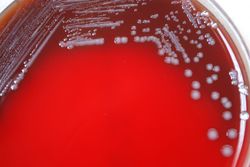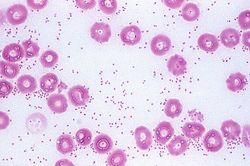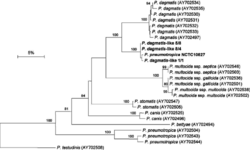Pasturella canis
Classification
Phylum: Proteobacteria
Class: Gammaproteobacteria
Order: Pasteurellales
Genus: Pasteurella
Species: Pasteurella canis
|
NCBI: Taxonomy |

Description and significance
Pasteurella canis, from Latin, canis ("dog") is a group of bacterial strains which are isolated from the oral and respiratory tracts of a wide variety of animals, including dogs, cats, rabbits, horses, sheep, cattle, ferrets, deer, and even california sea lions!(1-6) As such, “Micrococcus gallicidus,” from Latin, gallus ("cock"); and -cida ("murderer,") was the first scientific name used for these bacteria. (7,8) For a short time, they were unofficially placed in several different genera, such as Octopsis, Coccobacillus, and Eucystia. In 1887, Pasturella multicida was first isolated by Louis Pasteur, who was dissecting chickens to find the causitive agent of fowl cholera(9) accordingly, the newly isolated P. multicida was named in his honor. P. multicida underwent reclassification in 1932, after which the seperate species Pasturella canis was created.(9)

Before current modern molecular technology was available, species were often labeled based on staining and the hosts from where species were isolated. Accordingly, the name "multocida" from Latin, multi (“much, many”), and -cida (“murderer”) was ultimately adopted to represent all the Pasteurella species.(9) Up until 1932, the genus Pasteurella only consisted of Pasteurella multocida. In 1985, however, Pasteurella underwent taxonomic reclassification based on DNA hybridization, which lead to taxonomists to create several new Pasturella species, including our friend P canis. P. canis, now newly classified, was found to include two biotypes: biovar 1, which originates primarily from canines, and biovar 2, a type originating in bovines.
Genome and genetics
Unfortunately, the genome sequence of P. canis has yet to be sequenced. However, as it is closely related to P. multicida, a bit of relevant information may be gained by looking at the genome of its relative. To sequence the genome of P. multicida, May et al used the random shotgun approach to generate more than 53,000 sequence fragments from strain Pm70, which they then assembled into a single circular sequence of 2,257,487 base pairs. The putative origin of replication of the chromosome was identified on the basis of the presence of dnaA boxes, characteristic oligomer skew, and G-C skew immediately before the first putative coding sequence, gidA. The entire sequence specified 2,014 potential coding DNA sequences with an average size of 998 base pairs, which in sum accounted for 89% of the entire chromosome. The remaining 11% of the sequence consisted of 6 complete rRNA operons, 57 tRNA genes representing all 20 amino acids, and a relatively small number of noncoding elements. Sequence comparisons identified 200 CDSs (10%) unique to Pm and 1,197 CDSs with orthologs in both the Hi and Escherichia coli (Ec) genomes. Because 26% of the CDSs were most similar to hypothetical proteins of unknown functions, as is seen in other completed microbial genomes, a substantial portion of P. multicida’s biochemistry and cell biology remains to be discovered.(10)
In a bigger picture genetic view, P. canis belongs to the gammaproteobacteria, and is most closely related to Actinobacillus and Haemophilus.(11)

Nutrition and metabolism
All of the currently reported P. canis strains are gram-negative, oxidase-positive, nonmotile, fermentative rods.(11,12) From laboratory observation and culture, it has been noted that colonies of P. canis are non-acid-fast and bipolar stained.(13, 14) Colonies grow well on 5 percent sheep blood (the preferred culture medium), chocolate, or Mueller-Hinton agar; growth is uncommon on MacConkey's agar. Colonies of P. canis are 1 to 2 mm in diameter after 24 hours of growth at 37ºC and are opaque and grayish.(15) A slight greening underneath the colonies may be noted, and most strains recovered from clinical specimens are catalase, oxidase, indole, sucrose, and decarboxylate ornithine-positive. The indole-positive species exhibit a mouse-like odor, and media containing vancomycin, clindamycin, and/or amikacin have been used to select for Pasteurella.(16) Potential bacterial virulence factors include the capsule, lipopolysaccharide, sialidases, hyaluronidase, surface adhesins, and iron acquisition proteins.(17)
Pathology and Ecology
Animal Infections
P. canis can be found in healthy domesticated, farm-raised, and wild animals, and infects a wide variety of each, including dogs, cats, rabbits, horses, sheep, cattle, ferrets and deer. The bacteria are normally isolated from the oral cavities and respiratory tracts of these animals, and as such, easily colonize human beings through bites that puncture the epidermis. P. canis biotype 1 was shown to secrete a toxin analogous to P. multocida toxin, but its identity remains unknown, and P. canis is responsible for a number of canine-specific infections, including systemic infection, external otitis, bacterial rhinitis, vertebral osteomyelitis, meningomyelitis (a type of myelitis), bronchopneumonia, tracheitis, paranasal sinus inflammation, and toxicosis.(18-23) These diseases caused by P. canis are the most studied, as dogs are commonly found in close association with human beings. In addition to the canine diseases caused, horses infected with the bacteria may develop arthritis.(3) P. canis can also cause mild to severe pneumonia in cattle and various systemic infections in sheep, cats, rabbits, and deer.
Human Infections
In humans, P. canis is mainly transmited via animal bites, scratches, or licking over wounds.(24) In some cases, however, patients developed infections without any scratches or puncture wounds, as, for example, a patient exposed to rabbit secretions who became infected with P. canis.(6) In addition, individuals with rheumatoid arthritis, cirrhosis, and diabetes mellitus, and the immunocompromised are more susceptible to bacterial infection by P. canis. Most of the time, P. canis causes soft-tissue and wound infections, as well as systemic bacteremia. As an opportunistic pathogen, the infections that P. canis is able to cause vary on the location, and include peritonitis, conjunctivitis, osteomyelitis, and arthritis.(25) P. canis has also been shown to infect joint prosthetics quite easily.(26)
Current Research
Recent research has focused mostly on the various systemic infections caused by P. canis, as, being an opportunistic pathogen, it cannot be readily linked to a certain symptom or disease.(3, 18-26) As the bacteria has been identified in many instances of bite infections or wounds, research has also focused on rapid identification of P. canis using 16sRNA and various other methods.(27) Other than identification and characterization, not much has been done with P. canis, leaving the field open to a multitude of possible research directions, including elucidating the protein similarities or relatedness to its close cousin, P. multicida.(15)
References
(1) Haraa, Hiroyuki, et al. "Pasteurella canis osteomyelitis and cutaneous abscess after a domestic dog bite." Journal of the American Academy of Dermatology 46.5 (2002): S151-S152.
(2) Biberstein, Ernst L., et al. "Distribution of indole-producing urease-negative pasteurellas in animals." Journal of Veterinary Diagnostic Investigation 3.4 (1991): 319-323.
(3) Bourgault, Andree, Rianatou Bada, and Serge Messier. "Isolation of Pasteurella canis from a foal with polyarthritis." The Canadian Veterinary Journal 35.4 (1994): 244.
(4) Hansen, Mie Johanne, et al. "Occurrence of Pasteurellaceae bacteria in the oral cavity of selected marine mammal species." Journal of Zoo and Wildlife Medicine 43.4 (2012): 828-835.
(5) Sarkozi, R., L. Makrai, and L. Fodor. "Characterization of Pasteurella species isolated from oral cavity of cats." Magyar Allatorvosok Lapja 133.9 (2011): 540-545.
(6) Yefet, E., et al. "Unusual infection--Pasteurella canis bacteremia in a child after exposure to rabbit secretions." Harefuah 150.1 (2011): 13-5.
(7) Albert, T. J., and Dennis L. Stevens. "The first case of Pasteurella canis bacteremia: a cirrhotic patient with an open leg wound." Infection 38.6 (2010): 483-485.
(8) Rashid, Noor-Khairul, et al. "Pasteurella canis isolation following penetrating eye injury: a case report." Case reports in ophthalmological medicine 2012 (2012).
(9) Christensen, Henrik, et al. "Revised description and classification of atypical isolates of Pasteurella multocida from bovine lungs based on genotypic characterization to include variants previously classified as biovar 2 of Pasteurella canis and Pasteurella avium." Microbiology 150.6 (2004): 1757-1767.
(10) May, Barbara J., et al. "Complete genomic sequence of Pasteurella multocida, Pm70." Proceedings of the National Academy of Sciences 98.6 (2001): 3460-3465.
(11) Bergey, D.H, George M. Garrity, David R. Boone, Don J. Brenner, Paul De. Vos, Noel R. Krieg, and Michael Goodfellow. Bergey's Manual of Systematic Bacteriology. New York: Springer, 2001. Print..
(12) Illinois Industrial University (Urbana, and Ill.). Board of Trustees. Annual Report of the Board of Trustees of the Illinois Industrial University. Illinois Industrial University, 1869.
(13) Burrill, T.J. "New species of Micrococcus (bacteria)". Am. Nat. 17: 319–320.
(14) Mutters, R., et al. "Reclassification of the genus Pasteurella Trevisan 1887 on the basis of deoxyribonucleic acid homology, with proposals for the new species Pasteurella dagmatis, Pasteurella canis, Pasteurella stomatis, Pasteurella anatis, and Pasteurella langaa." International Journal of Systematic and Evolutionary Microbiology 35.3 (1985): 309-322.
(15) Lax, Alistair. "The Pasteurella multocida toxin: a new paradigm for the link between bacterial infection and cancer." Pasteurella multocida. Springer Berlin Heidelberg, 2012. 131-144.
(16) Zbinden, Reinhard. "Aggregatibacter, Capnocytophaga, Eikenella, Kingella, Pasteurella, and other fastidious or rarely encountered gram-negative rods." Manual of Clinical Microbiology, Eleventh Edition. American Society of Microbiology, 2015. 652-666.
(17) Zbinden, Reinhard, and Alexander von Graevenitz. "Actinobacillus, Capnocytophaga, Eikenella, Kingella, Pasteurella, and other fastidious or rarely encountered Gram-negative rods." Manual of Clinical Microbiology, 10th Edition. American Society of Microbiology, 2011. 574-587.
(18) Yefet, E., et al. "Unusual infection--Pasteurella canis bacteremia in a child after exposure to rabbit secretions." Harefuah 150.1 (2011): 13-5.
(19) Holst, Elisabet, et al. "Characterization and distribution of Pasteurella species recovered from infected humans." Journal of Clinical Microbiology 30.11 (1992): 2984-2987.
(20) Csébi, Péter, et al. "Vertebral osteomyelitis and meningomyelitis caused by Pasteurella canis in a dog—Clinicopathological case report." Acta Veterinaria Hungarica 58.4 (2010): 413-421.
(21) Knotek, Z., et al. "Diseases of Nasal Cavity in the Dog. Aetiology, Symptomatology, Diagnostics." Acta Veterinaria BRNO 70.1 (2001): 73-82.
(22) Malayeri, Hamed Zamankhan, Shahram Jamshidi, and Taghi Zahraei Salehi. "Identification and antimicrobial susceptibility patterns of bacteria causing otitis externa in dogs." Veterinary Research Communications 34.5 (2010): 435-444.
(23) Hazelton, Briony J., Matthias W. Axt, and Cheryl A. Jones. "Pasteurella canis osteoarticular infections in childhood: review of bone and joint infections due to pasteurella species over 10 years at a tertiary pediatric hospital and in the literature." Journal of Pediatric Orthopaedics 33.3 (2013): e34-e38.
(24) Balikoglu-Yilmaz, Melike, et al. "Pasteurella canis and Granulicatella adiacens conjunctivitis outbreak resistant to empirical treatment in a child welfare agency." Journal of Pediatric Ophthalmology and Strabismus 49.5 (2012): 314-319.
(25) Castellano, I., et al. "Pasteurella canis peritonitis in a peritoneal dialysis patient." Peritoneal Dialysis International 31.4 (2011): 503-504.
(26) Mondon, D., et al. "First report of a total knee arthroplasty infected by Pasteurella canis." Medecine et Maladies Infectieuses 40.10 (2010): 600-601.
(27) Gautier, Anne-Lise, et al. "Rapid and accurate identification of human isolates of Pasteurella and related species by sequencing the sodA gene." Journal of Clinical Microbiology 43.5 (2005): 2307-2314.
Authored by Joshua Place, a student of CJ Funk at John Brown University
